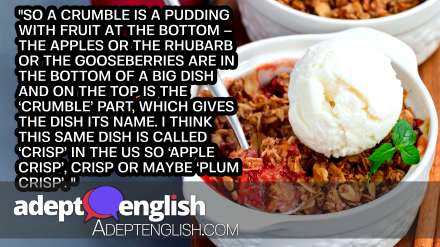A Pudding English Speaking Topic
It’s been cold here in the UK and nothing makes the cold outside fade away faster than British comfort food. I’m sure, wherever you come from, you have a similar process of making things just a little better with some pleasant kitchen smells and tasty dishes. Well, in my house we like a good pudding and a family favourite is a fruit crumble with lots of custard. So today’s English speaking topic is about a classic British pudding and the English vocabulary you would use in an English kitchen.
Although where we live is quite a built up area, if you walk far enough (about 2 miles) you can eventually find some lovely green forest and paths to walk. Which is exactly what we did last weekend, only it was sooo cold I could hardly feel my toes when I got back to our house. So in typical British "keep calm and carry on fashion" I made a classic warm British pudding and in no time at all I was feeling warm and comforted.
So today I’m going to walk you through several idioms, metaphors and vocabulary that you would encounter if you needed to use a British kitchen. It will include weights, measurements and numbers in English. Although you might think this is a simple lesson, there is an awful lot of English language related complexity going on in here.
We’ve done other English lessons about puddings but not included the recipe. This one is superb for a cold start to the new year and the upside to this lesson is the opportunity to make a lovely pudding and eat it! We think how you learn the English for any topic must be done in an interesting way. Learning has to be fun and interesting as well as efficent and effective. You can find out more about out way to learning to speak English fluently here.
Most Unusual Words:
Pinch
Sour
Stalk
Ovenproof
Fashion
Most common 3 word phrases:
| Phrase | Count |
|---|---|
| The English For | 2 |
| How To Learn | 2 |
Listen To The Audio Lesson Now
The mp3 audio and pdf transcript for this lesson is now part of the Adept English back catalogue . You can still download and listen to this lesson as part of one of our podcast bundles.Transcript: A Yummy English Speaking Topic Mmm Puddings
Hi and welcome to this podcast from Adept English.
Well, I hope you are warm and comfortable wherever you are in the world. And that if you are locked down like we are, then you’ve got good food, good company and some entertainment. Even, though your company may be online, if you live on your own.
Today I thought that I’d do something simple for your English language learning – and something which is comforting perhaps in these difficult times. What about a nice recipe which is really easy? And it’s something that you may already make at home or it may be new to you. But it’s very easy and fairly universal.
And if you know this simple recipe and you make it yourself, then understanding the English for this podcast should be nice and easy for you – and good practice. How to learn the English for things in your kitchen, things you eat? How to learn English fast and effectively? Look no further than this podcast.
Learn English with cooking
So what about a ‘crumble’, that’s CRUMBLE? So this is a traditional British pudding and it’s made with fruit. There’s a variety of types of fruit that you can use – but the most traditional ones are apples, rhubarb or gooseberries. Apples, APPLES – that’s probably a word you know as in the saying ‘An apple a day keeps the doctor away’ because apples are healthy.
But what about the other two? Well, rhubarb, RHUBARB is a funny kind of fruit – it’s actually a stalk, STALK – that means the long thin part of a plant – and it’s got quite big leaves on the ends of the stalks, but you don’t eat those. It’s also very sour, SOUR if it’s uncooked. ‘Sour’ means it’s likely to make you pull a face when you taste it. But rhubarb is nice cooked in a pan with some sugar. And the other fruit I mentioned ‘gooseberries’ – the pronunciation of this word varies a little across the UK from ‘gooozeberry’, like I might say to ‘guzberry’. These are little green berries that grow on a spiky bush – and like the rhubarb, they’re very sour until they’re cooked.
What is a fruit crumble?
So a crumble is a pudding with fruit at the bottom – the apples or the rhubarb or the gooseberries are in the bottom of a big dish and on the top is the ‘crumble’ part, which gives the dish its name. I think this same dish is called ‘crisp’ in the US so ‘apple crisp’, CRISP or maybe ‘plum crisp’.
I think technically a ‘crisp’ has less topping – British crumble topping may be up to about an inch thick, so that you can’t actually see the fruit. So my recipe is for ‘crumble’, British-style. You can vary the fruit you use, whatever is in season. Citrus fruits probably won’t work well, but berries, apples, pairs, plums - they all work. And you can even add bananas instead of sugar to sweeten it.
📷
A photograph of a plum crumble pie or plum crisp with oats and spices, served with ice cream. The American version of a British Crumble pudding.
It even works with tinned fruit, like peaches or apricots, though of course, fresh ones are nicer. The only fruit I don’t think would work here would be citrus – so that’s oranges, tangerines, lemons etc.
Learn English with the recipe for fruit crumble
So here goes with the recipe – this isn’t one I look up, it’s just in my head and how I’ve always done it. You will need about 8 ounces of plain white flour – or wholemeal or brown flour will work too. 8 ounces is of course an imperial measurement – in grams it’s around 225g flour. You’ll need 3 ounces of butter – that’s around 85g of butter. And then the same weight of sugar – so 85g of sugar. You can use white, you can use brown, you can use demerara sugar.
So put the flour and the butter in a bowl, with a pinch, PINCH – that’s a tiny bit – of salt, and prepare to get your hands all messy. You need to ‘rub in’ the butter and flour. This means you do a r ubbing motion with your hands, so that the flour and butter combine – and eventually you end up with a bowl of what look like ‘bread crumbs’.
And you’ll find that if you shake the bowl from side-to-side, any big lumps of butter will come to the top, so that you can ‘rub them in’ too and have a nice even mix. Once you’ve got something that looks like breadcrumbs, then stir the sugar in too.
Video
Learn English and cook your crumble
If you’re doing apples or pears, it’s important that you do your crumble topping first – otherwise your fruit, your apples or pears will be going brown, if you leave them in the open air. So, once your crumble topping is ready, ‘peel’ your apples, that’s PEEL meaning that you cut off the skin – and chop them up. ‘To chop’, CHOP means to cut up into little pieces. Sometimes it’s nice in a crumble to do a mix of fruit.
If you’ve got bananas which are over-ripe, they’re good with apples. And the apples? Well, you can use ordinary eating apples, but if you can get a cooking apple variety – like a Bramley’s – then it will be even nicer. Sometimes it’s good to put in cherries or other berries with your apples – makes it nice and pink! There’s a real variety of what you can do. When you’re ready, with your fruit all chopped up in the bottom of your ovenproof dish, just simply tip the crumble mixture over the top and level it out. You then cook this in a pre-heated oven.
An ‘ovenproof dish’, OVENPROOF that I mentioned just now – that means a dish that can go into the oven. Cook your crumble in the oven at around 180C – so that’s around 350F. And how long it takes may vary. I usually reckon about 35-40 minutes, but of course if you smell burning, obviously take it out sooner! It’s nicer if it’s done longer though. If you’re aiming at a nice, golden brown top and when you stick a fork through it, the fruit should be soft and cooked. There’s no need to precook the fruit – it’s in the oven long enough, so just whizz it straight in.
How to eat your crumble
Now you can eat this hot from the oven or cold. It’s nice with custard, CUSTARD – that’s a British thing too, or with cream or with ice cream. And of course, you can vary the recipe. Sometimes people replace some of the white flour with oats to give it more crunch. And you can add raisins or dried fruit too to the fruit part – and cinnamon.
It’s a good way of using up fruit, say if you’ve got a fruit tree and lots of fruit to get through – or even better, if you’ve picked fruit when you were out for a walk, that was growing outside – and it’s free! Sometimes, in the UK in September, we pick blackberries – and they’re good with apples. In a crumble, they give a nice pink colour. And if you don’t eat all your crumble at once, you can cover it up and put it in the fridge and it will still be nice for a couple of days.
Download The Podcast Audio & Transcript
So there we are - how to learn the English for a recipe. Some home cooking along with your English language learning. There are 101 ways to learn English, but I think it’s important that you learn English in association with nice things – and what could be more comforting at the moment than a bit of home cooking? It’s good also to know vocabulary for familiar things, inside your house. How to learn English by yourself? Don’t forget to listen to this podcast a number of times, until you can recognise all the words and you can understand the English without having to try!
Don’t forget there’s more on our website, especially our PODCAST BUNDLES
If you enjoyed this podcast, then why not go to our website and have a look at our podcast bundles? You can listen to our latest podcasts for free. But also for a small fee, you can get 50 of our podcasts to download to your mobile phone or your tablet.
Boost Your Learning With Adept English
These are what we call our ‘podcast bundles’ and there are a number of ‘bundles’ to choose from. This is a lot of listening – so well worth it. And it will help you follow Rule Three of Adept English, and do your listening practice regularly. Regularly is best for language learning.
Goodbye
Enough for now – enjoy your crumble! And have a lovely day. Speak to you again soon. Goodbye.







